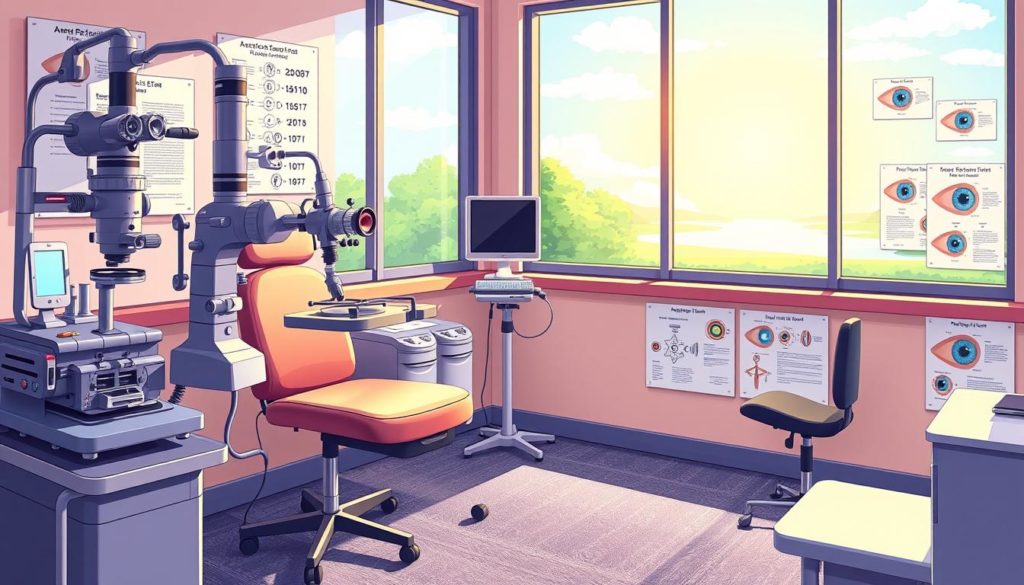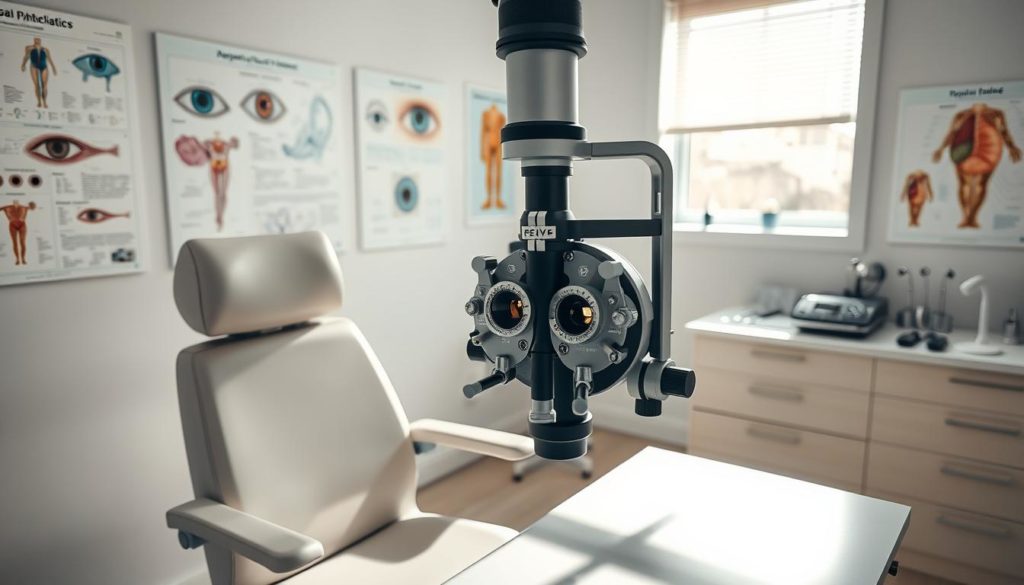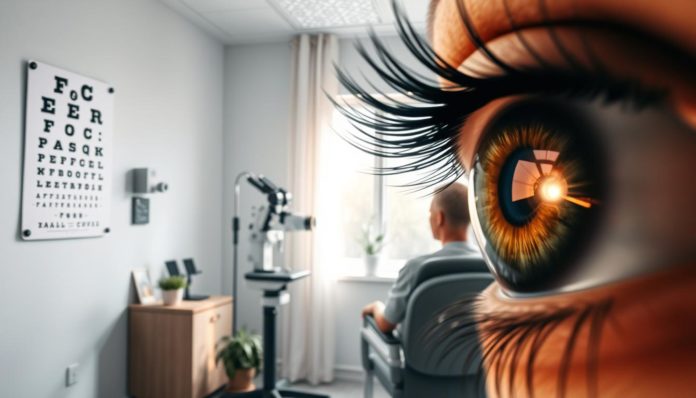Did you know over 75% of vision problems could be prevented? Yes, an eye exam does more than test your sight. It can spot early signs of big health worries, like diabetes and hypertension. Knowing what happens in an eye exam can ease your nerves and help you get the most from these essential visits.
An eye exam is a set of tests with special gear and lights. They check your vision, eye health, and other health clues. These exams are easy and pain-free. They include tests like visual acuity, refractive assessment, visual field tests, ophthalmoscopy, slit-lamp exams, and tonometry.
After your eyes are dilated, you might find lights too bright or your vision blurry for a while. Eye exams do more than update your glasses or contacts. They’re a key step in keeping your eyes healthy. Use these tips for your next eye exam to be ready for your visit to the eye doctor.
Understanding the Eye Exam Process
Preparing for an eye check-up might seem overwhelming, but knowing what occurs makes it easier. You’ll discuss your medical history and any vision problems. This ensures the care you receive is top-notch.

Beginning with Medical History
Your eye exam starts with a detailed look at your medical history. Your specialist needs this info to spot potential vision issues. It’s key to mention any health problems, like diabetes or high blood pressure.
Discussion of Vision Problems
Talking about any vision troubles is key when you’re getting ready for an eye exam. Tell your doctor if you’re seeing blurry, having double vision, or trouble seeing at night. This helps them customize your exam.
Also, bring your current glasses or contacts. This way, your prescription can be updated if needed. Always keep in touch with your eye doctor. This makes sure your exams match your health needs.
Common Eye Exam Procedures
Going to the eye doctor is a chance to learn a lot. There are different steps in an eye exam. Each one checks your eye health and how well you see.

Visual Acuity Test
The first step is often the Visual Acuity Test. You read letters on a chart. This shows how sharp your vision is and if you need glasses.
Refraction Test
If you have trouble seeing clearly, the Refraction Test is next. It uses tools like the phoropter. This finds the perfect lens prescription for you by seeing how light bends in your eye.
Visual Field Test
The Visual Field Test checks your side vision. It’s key for spotting issues like glaucoma. You’ll look straight ahead while lights flash on the sides to test your vision range.
| Procedure | Purpose | Instruments Used |
|---|---|---|
| Visual Acuity Test | Assess clarity of vision | Eye chart |
| Refraction Test | Determine lens prescription | Phoropter, Autorefractor |
| Visual Field Test | Check peripheral vision | Visual Field Machine |
Knowing about these tests can make your eye exam less stressful. Each test is key for good eye health and clear vision.
Ophthalmoscopy: Examining the Retina
Ophthalmoscopy is key for setting Eye Exam Expectations right. It lets doctors look closely at the retina, optic disk, and blood vessels. This makes sure your eye’s health is accurately checked.
Purpose of Ophthalmoscopy
Ophthalmoscopy aims to closely check the retina and optic structures. It helps eye specialists spot different eye issues early, like glaucoma, macular degeneration, and diabetic retinopathy. It gives patients a good understanding of how in-depth the eye exam will be.
Procedure Steps
The steps of the ophthalmoscopy ensure a detailed eye exam:
- Pupil dilation: Drops widen the pupils for a better retina view and a detailed check-up.
- Use of a light source: A special light looks into the eye once the pupils are dilated.
- Detailed scanning: The doctor checks the retina, optic disk, and blood vessels for any unusual signs.
Here’s a comparison of ophthalmoscopy techniques used in exams:
| Ophthalmoscopy Type | Scope | Advantages | Disadvantages |
|---|---|---|---|
| Direct Ophthalmoscopy | Short-range view of the retina | Portable, quick diagnosis | Limited view, requires pupil dilation |
| Indirect Ophthalmoscopy | Wide view of the retina, optic disk, and blood vessels | Comprehensive, detailed examination | Involves complex equipment, patient discomfort |
Preparing for an Eye Exam
Getting ready for your eye exam is key to a thorough check-up. Follow these eye exam tips to help you prepare. This will make sure your visit is detailed and accurate.
What to Bring
Here are a few important items to bring to your eye exam:
- Your current glasses or contact lenses
- Prescriptions or details of any lenses you have used
- A list of any medications you are taking, as some can impact vision
- Any past eye exam records if available
Medications and Conditions to Disclose
Tell your eye doctor about all your health conditions and medicines. This information helps them see how your health might affect your eyes. Here’s a comprehensive eye exam checklist to keep in mind:
| Items | Details |
|---|---|
| Medical Conditions | Diabetes, Hypertension, Chronic conditions |
| Eye History | Glaucoma, Macular Degeneration |
| Medications | Ongoing treatments, Dosage details |
Being prepared for your eye exam helps everything go smoothly. It allows your eye doctor to provide the best care tailored to you.
What is Tonometry?
Tonometry measures the pressure inside your eyes, known as intraocular pressure (IOP). This test is key for finding glaucoma early. Knowing about Eye Exam Expectations shows why it’s valuable in eye care.
Detecting Glaucoma
It’s crucial to catch glaucoma early to avoid losing vision. Tonometry finds high eye pressure, a big glaucoma risk. Finding high IOP early leads to quick treatment, helping to keep eyes healthy. These eye checks help prevent damage to the optic nerve.
Different Methods
Several tonometry methods have their benefits:
- Goldmann Applanation Tonometry: This top method uses a prism to measure IOP by flattening a cornea part.
- Handheld Tonometers: These devices are easy to use anywhere to check eye pressure.
- Noncontact (Air Puff) Tonometry: A fast puff of air tests IOP, no contact needed.
Knowing these methods helps set correct expectations for eye exams. They show why regular checks are important. For more info, see Mount Sinai’s detailed guide on this vital test.
Eye Exam Expectations
Knowing what happens in an eye exam helps ease any worries. These exams check your sight and health of eyes. They last from 30 minutes to an hour and are usually painless.
A full eye exam has many parts. Its main aim is to test how well you can see and find any eye problems. Here are the key things you’ll go through during the exam:
- History Taking: Your eye doctor will ask about your health and any vision issues you’re having.
- Visual Acuity Test: This test uses an eye chart to assess your vision from different distances.
- Refraction Test: Determines the precise prescription you need for glasses or contacts.
- Visual Field Test: Looks for blind spots and checks the complete range of your vision.
Knowing these steps helps you understand your eye exam results better. An accurate diagnosis and the right treatment follow from a good understanding of the results. Your doctor will go over what each test means and how it affects your eye health.
Being informed about your eye exam makes the experience smoother and more positive. This knowledge also prepares you for a successful visit to the eye doctor.
Role of Corneal Topography in Eye Exams
Corneal topography is key in today’s eye exams. It maps the cornea’s surface with details. This method spots different eye conditions and finds the best contact lenses fit. Knowing about topography can make your eye exam easier and boost eye health.
Assessing Astigmatism
Astigmatism is a usual vision issue caused by the cornea’s uneven shape. Corneal topography checks the cornea’s shape in eye exams. This scan shows the type and severity of astigmatism. It helps eye doctors make customized vision correction plans.
Determining Contact Lens Fit
Finding the right contact lenses starts with knowing the cornea’s size. Corneal topography maps the cornea’s curve to find the best lens fit. This step is crucial for comfortable lenses that correct vision well. It’s important to know how topography helps get lenses that fit perfectly.
Interpretation of Eye Exam Results
Understanding your eye exam results is key to good vision health. It helps find out if you need glasses and checks for eye problems. This ensures you get the best care for your eyes.
Understanding Visual Acuity Scores
Visual acuity scores measure how clear your vision is. At your eye exam, these scores look like a fraction, for example, 20/20. The first number is the distance you stand from the chart, and the second number is the smallest line you can read clearly.
If you have a 20/40 score, it means you see at 20 feet what someone with perfect vision sees at 40 feet. This score helps your eye doctor understand your vision clarity.
Discussion of Eye Health
Talking about your eye health is important after an exam. It can reveal conditions like glaucoma or macular degeneration. If there’s a problem, your eye doctor might suggest more tests or treatments to keep your vision sharp.
Having regular eye exams is crucial. They help track your eye health and meet your Eye Exam Expectations. This way, your eyes stay in good shape.
Emergency Eye Exams Explained
When you urgently need care for sudden vision loss, severe eye pain, or an eye injury, emergency eye exams are vital. They help you understand what to expect. And they show when it’s critical to get help right away. This quick action can stop permanent damage to your eyes.
When to Seek Urgent Care
Need an emergency eye exam if you suddenly can’t see, have sharp eye pain, or see damage to your eye. It’s important to act fast in these cases. Learning about Eye Exam Expectations and tips can save your sight.
Possible Emergency Procedures
During an emergency eye exam, doctors might need to check your eye pressure quickly. This is to rule out acute glaucoma, which needs fast treatment. They may also need to remove something stuck in your eye or treat a scratch on your eye’s surface. For more info on eye exams, check out this comprehensive guide.
FAQ
What can I expect during an eye exam?
You can expect several tests to check your vision and eye health. Special tools and lights are used in these tests. They are non-invasive and pain-free, including things like visual acuity tests and tonometry.
How should I prepare for an eye exam?
Bring your glasses or contacts, and a list of your medications. Also, be ready to talk about your health. This helps the eye doctor give you a personalized exam and advice.
What is the purpose of visual acuity tests?
Visual acuity tests check how clear your vision is. They use an eye chart. This helps find any vision problems and see if you need glasses.
How is tonometry performed to detect glaucoma?
Tonometry is a test that measures your eye pressure. It can be done with an air puff or a tonometer. It’s vital for spotting high pressure early to prevent damage to your optic nerve.
What should I expect after pupil dilation?
After your pupils are dilated, you might find lights too bright and your vision blurry. Bring sunglasses for the light sensitivity after your appointment.
What is ophthalmoscopy and why is it important?
Ophthalmoscopy lets doctors see the back of your eye. It examines the retina and optic disk. This is key for checking the health of these areas closely.
How often should I get an eye exam?
How often you need an eye exam depends on your health history. Talk with your eye doctor about it. Regular check-ups help keep your eyes healthy.
What does corneal topography assess?
Corneal topography maps your eye’s surface. This is important for spotting astigmatism and fitting contacts right. It gives a detailed look at your cornea’s shape.
How are eye exam results interpreted?
Your eye exam results include a score for vision clarity. Your doctor will talk about your eye health and if you need new glasses or a prescription change. They also look for signs of eye diseases.
When should I seek an emergency eye exam?
If you suddenly lose vision, feel eye pain, or have an injury, get an emergency exam. Immediate care may include special tests for conditions like acute glaucoma or removing something from your eye.


